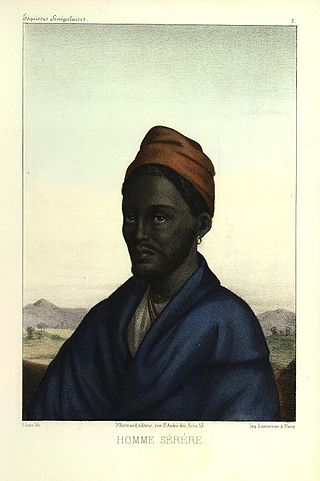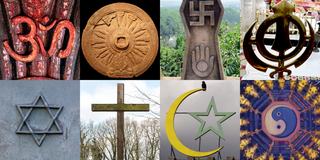
The Serer-Ndut or Ndut also spelt are an ethnic group in Senegal numbering 38600. They are part of the Serer people who collectively make up the third largest ethnic group in Senegal. The Serer-Ndut live mostly in central Senegal in the district of Mont-Roland, northwest of the city of ancient Thiès.

A religious symbol is an iconic representation intended to represent a specific religion, or a specific concept within a given religion.

Senegalese wrestling is a type of folk wrestling traditionally performed by the Serer people and now a national sport in Senegal and parts of The Gambia, and is part of a larger West African form of traditional wrestling. The Senegalese form traditionally allows blows with the hands (frappe), the only one of the West African traditions to do so. As a larger confederation and championship around Lutte Traditionnelle has developed since the 1990s, Senegalese fighters now practice both forms, called officially Lutte Traditionnelle sans frappe and Lutte Traditionnelle avec frappe for the striking version.
The Serer-Noon also called Noon are an ethnic people who occupy western Senegal. They are part of the Serer people though they do not speak the Serer-Sine language natively.
The Serer religion, or a ƭat Roog, is the original religious beliefs, practices, and teachings of the Serer people of Senegal in West Africa. The Serer religion believes in a universal supreme deity called Roog. In the Cangin languages, Roog is referred to as Koox, Kopé Tiatie Cac, and Kokh Kox.

The prehistoric and ancient history of the Serer people of modern-day Senegambia has been extensively studied and documented over the years. Much of it comes from archaeological discoveries and Serer tradition rooted in the Serer religion.
This is a list of states headed by the Serer Lamanes. The Lamanes have a historical, economic and religious significance in Serer countries. The following pre-colonial kingdoms and new states (post-independence) were for a long time dominated by the Serer Lamanic class :
Father Henry Gravrand was a French Catholic missionary to Africa and an anthropologist who has written extensively on Serer religion and culture. He was one of the leading pioneers of interfaith dialog and believed that African religion was the "'first covenant between God and man". His works about the Serer people are cited by other historians and scholars writing on Serer history, religion and culture, for instance Martin A. Klein, Charles Becker, Alioune Sarr, Marguerite Dupire, Issa Laye Thiaw, etc. Papa Massène Sene argues that his approach lacks scientific rigor and include fundamental linguistic and historical errors. Alioune Sarr noted that Gravrand reported an oral tradition describing what he called the "Battle of Troubang", a dynastic war between the two maternal royal houses of Ñaanco and the Guelowar, an off-shot and relatives of the Ñaanco maternal dynasty of Kaabu, in modern-day Guinea Bissau. According to Charles Becker, Gravrand is confusing a description of the 1867 Battle of Kansala.
Lamane Jegan Joof, was a Serer lamane who according to Serer tradition founded the Serer village of Tukar now part of present-day Senegal. The Raan Festival takes place each year at Tukar, two weeks after the appearance of the new moon in April.
Tukar a large village in Senegal. Attached to the rural community of Ngayokhem, it is located in the area of the pre-colonial Kingdom of Sine, west of Senegal. The population is overrun by the Serers. As of 2006 to 2007, the population was estimated at 3000. Ndokh, which was a colony of Tukar, is now a separate village.
The Saafi people, also called Serer-Safene, Safene, etc., are an ethnic group found in Senegal. Ethnically, they are part of the Serer people but do not speak the Serer language nor a dialect of it. Their language Saafi is classed as one of the Cangin languages. In Senegal, they occupy Dakar and the Thies Region.
The Palors also known as Serer-Palor, among other names, are an ethnic group found in Senegal around the west central, west southwest of Thiès. They are a sub-group of the Serer ethnic group found in Senegal, the Gambia and Mauritania. Although ethnically Serers, they do not speak the Serer language but one of the Cangin languages. Their language is Palor.
Roog or Rog is the Supreme God and creator of the Serer religion of the Senegambia region.
Kopé Tiatie Cac is the Supreme Creator in the Serer religion. Kopé Tiatie Cac is the name used by the Ndut people to refer to the Supreme being. Among the Ndut and followers of Serer religion, Kopé Tiatie Cac is associated with death and plague (pisti).
The Serer creation myth is the traditional creation myth of the Serer people of Senegal, the Gambia and Mauritania. Many Serers who adhere to the tenets of the Serer religion believe these narratives to be sacred. Some aspects of Serer religious and Ndut traditions are included in the narratives contained herein but are not limited to them.
Pangool singular: Fangool, are the ancient saints and ancestral spirits of the Serer people of Senegal, the Gambia and Mauritania. The Pangool play a crucial role in Serer religion and history. In a religious sense, they act as interceders between the living world and the supreme being Roog or Koox. In a historical sense, the ancient Serer village and town founders called Lamanes were believed to be accompanied by a group of Pangool as they travelled in search of land to exploit. These Lamanes became guardians of Serer religion and created shrines in honour of the Pangool, thus becoming the custodians of the "Pangool cult".
Tiurakh is one of the demi-gods of the Serer people of Senegal, the Gambia and Mauritania. In the Serer religion, Tiurakh is regarded as the god of wealth or property. Like his adversary Takhar, they are both venerated and worshipped at the foot of the tallest trees in Serer country.
The Njuup tradition is a Serer style of music rooted in the Ndut initiation rite, which is a rite of passage that young Serers must go through once in their lifetime as commanded in the Serer religion.
Serer maternal clans or Serer matriclans are the maternal clans of the Serer people of Senegal, the Gambia and Mauritania. The Serer are both patrilineal and matrilineal. Inheritance depends on the nature of the asset being inherited – i.e. whether it is a maternal asset which requires maternal inheritance or paternal asset requiring paternal inheritance (kucarla). The Serer woman play a vital role in royal and religious affairs. In pre-colonial times until the abolition of their monarchies, a Serer king would be required to crown his mother, maternal aunt or sister as Lingeer (queen) after his own coronation. This re-affirms the maternal lineage to which they both belong (Tim). The Lingeer was very powerful and had her own army and palace. She was the queen of all women and presided over female cases. From a religious perspective, the Serer woman plays a vital role in Serer religion. As members of the Serer priestly class, they are among the guardians of Serer religion, sciences, ethics and culture. There are several Serer matriclans; not all of them are listed here. Alliance between matriclans in order to achieve a common goal was, and still is very common. The same clan can be called a different name depending on which part of Serer country one finds oneself in. Some of these matriclans form part of Serer mythology and dynastic history. The mythology afforded to some of these clans draws parallels with the Serer creation narrative, which posits that: the first human to be created was a female. Many Serers who adhere to the tenets of Serer religion believe these narratives to contain profound truths which are historic or pre-historic in nature.
The Xooy is a Serer divination ceremony held once a year in Fatick, Senegal. The Xooy is one of the most important and well known ceremonies in the Serer religious calendar, and is a national event in Senegal's cultural calendar which attracts government officials and dignitaries. The ceremony is held yearly at the Centre MALANGO in Sine, Senegal and attracts a large crowd from Senegal, and Serers from neighbouring Gambia and the diaspora. It is somewhat of a yearly pilgrimage. The Lebou also attend the ceremony in homage to their Serer ancestors. The Lebou genies are actual the Serer pangool. The Xooy takes place around late May early June before the rainy season where the Serer high priests and priestesses—the Saltigue dressed in their traditional gowns and hats takes centre stage to divine the future. There is a master of ceremonies, and as the public are seated in a circle, each Saltigue enters the circle in turn and give their divination on matters relating to the weather, politics, economics, health, etc. The ceremony goes on for two days —and throughout the night—accompanied by the rhythm of drums. The Serer people have traditionally been farmers, cattle herders, boat builders and fisher people. The Xooy therefore serves both a religious and agricultural function.








